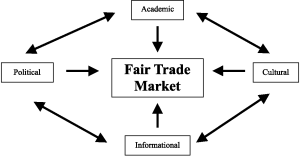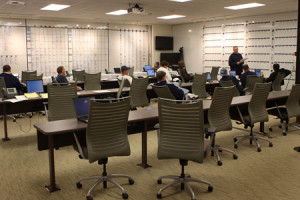Now that the Draft is rolling, teams are seeing their hard work come to fruition. As teams select, hopefully the best players available are also players that fill needs. Trade talks have commenced and this is when strategy and negotiating come to the forefront.
 Rolling the Dice
Rolling the Dice
The strategy of the NFL Draft truly comes into play when teams try to get players whose grades correlate with a Draft selection choice higher than they will actually be selected. As described earlier, teams may even try to trade down and acquire additional choices believing that the player(s) they covet will be available at a lower choice number. These executives gamble believing that no other team values the player as high. Or a team may have a situation in which there are 3 players that they have approximately the same interest in due to very close grades. A team could then explore trading down 1 or 2 spots to gain picks and still get one of the players that they want. It could happen that none of the teams in the following 3 spots wants to trade down, but as the Draft progresses, teams are more and more willing to trade. If a trade is executed, the worst case scenario is that 2 of the players they wanted are selected and the team will take the 1 player remaining of the 3 players desired. The best case scenario is that none of the players are selected, and the team can still choose among the 3 players.
But in that case, the team could try to trade down again! Is it worth it the risk? Or is it worth initially trading down 4 or 5 spots to gain an additional 4th round pick instead of trading down 2 spots and gaining a 6th round pick? What if a team calls with an offer for the team to move down 4 spots and in return offers an additional pick that is in a round higher than suggested by the trade chart? Is it worth the gamble to potentially lose the targeted player(s)? Sometimes it works out, sometimes it doesn’t. But the best answer is making sure the team always gets players it values and making sure the player grades best correspond to or exceed the selection pick number. Sometimes it is not worth gaining picks, because declining grades of the best available players is a very real factor.
 Fair Trade Market
Fair Trade Market
As the Draft value chart clearly illustrates, each pick holds an approximate value. So Draft picks are traded like currency. Just because a team acquires a pick does not mean it intends on selecting a player with the pick. A team might just be accumulating picks so that it can later use them to trade up in the Draft. Or the team might be giving itself the option to select a player at the position, but if no player of commensurate value is available at that pick, the team could then trade away the pick. Again, no guarantees on a ‘taker,’ but there is typically some interest. Some teams acquire 6th and 7th round picks with no intention of actually selecting players in those rounds; rather, these picks are used as extra ammunition to make trades in earlier rounds.
These teams view 6th and 7th round selections as players that will struggle to make the team anyway, and if they do make the team, it will likely be as practice squad players. For the most part, there is an obvious perceived significant flaw with players that have fallen this far, but with the right system in place and a hard working player, a team could just hit on the next Tom Brady or Marques Colston! Draft pick trading is not just limited to picks-for-picks. Sometimes teams will trade picks for players. A team might believe that a current player in the NFL is more valuable than any of the college players available at a certain selection number in the Draft. These trades are less prevalent, but sometimes other teams are looking to shed veterans, so they could gain a Draft choice and essentially replace the vacated roster position with a rookie Draft choice. The team acquiring the player sees the trade as gaining a solid veteran player for a 5th round pick that might not even make the team! However, these veteran players often carry larger contracts, so the acquiring team has to be sure the player is worth the salary he is due. Or maybe a team plays the strategy game again banking on the belief that the veteran player will be released soon anyway, so there is no need to give up anything for him in a trade.
 Value Time
Value Time
With the recent CBA renegotiation in 2011, maximum contract values for rookies were redefined. Prior to this renegotiation, the 6 year contract for the first selection choice in the Draft was $78 million! Last year, Andrew Luck’s base 5-year contract value was approximately $22.1 million. This makes a HUGE difference for NFL teams. Prior to the rule change lowering the maximum values of contracts, teams were afraid to select in the first half of the first round, because these contracts could cripple a team’s payroll. Having more than one of these contracts (from one or more Draft years) on a team would severely damage a team’s salary cap spending budget. While first round selections are multimillionaires, players selected in the following rounds are financial steals. Teams can load up on 2nd through 5th round picks knowing that these players will be valuable roster additions and still cost less than $1 million per season. Even if a player doesn’t pan out and needs to be released, the salary cap penalty is minimal. That should clarify why you see teams like New England load up on Draft picks every year and constantly infuse youth onto their roster.
Now you know how they can afford both returning veterans like Wes Welker AND an increased number of rookie Draft picks. Teams like New England often help their own cause by trading away picks for future years picks. Why give up picks in the current Draft? The answer is two-fold: First, the return is greater than the loss. In most cases trading a pick will net a pick one round higher than the pick given up. For example, trading away a 2013 3rd round pick will garner a 2014 2nd round pick in return. Second, the best teams can afford to wait a year for a pick, because success in the Draft over the years has left their rosters with less “holes” needing to be immediately filled.
 Not in Control
Not in Control
Conversely, there isn’t much action or strategy for the Draft eligible players themselves. They must simply wait by their phones until a team calls. They may talk to their agent in the interim, but it is best if that is the only person that calls. These players have high expectations and unstable emotions during the Draft, so their emotions can rise and fall with every incoming call. I have spoken with numerous players after the Draft that have told me they would get excited with every phone call, only for it to be their buddy asking if they were drafted yet or their uncle offering a word of support. Each player’s story is different, but whatever the case, all they can do is watch and wait until the Draft ends.
 Venture into the Unknown
Venture into the Unknown
After the first round, mock drafts really start to lose their value. Mock drafts tend to only apply for about the first 50 picks, because as the Draft progresses, preference and ranking among teams diversify more and more. Teams have gathered the most information about the best players, so as the Draft progresses less information might be available on players. The risk and unknown of players increase, and with teams having varying levels of risk-taking, it is unknown how soon a player will be drafted. Teams also view how a player might fit into its’ scheme differently, so a player with a better perceived fit will be taken sooner by a team. (The best players usually fit into just about any scheme.) A team has decreasing surety as the Draft progresses regarding the value of these aspects to other teams, so the mock draft’s value and accuracy decreases accordingly. Consequently, a team’s best methodology is to stick to the board!
Check back next Friday as I put a wrap on the series with Part VII which will cover potential pitfalls, the conclusion of the Draft, and the free-for-all that follows.


